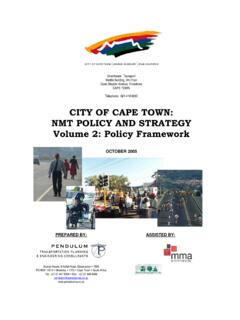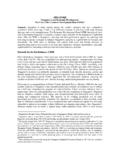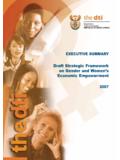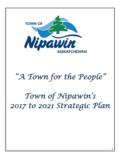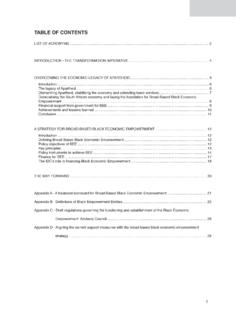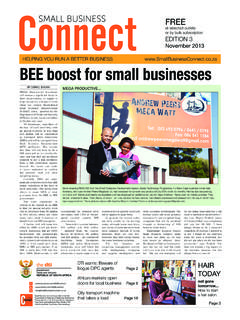Transcription of principles for improving Transportation options in rural ...
1 BY Li LLY Shoup and Becca homa oF TranSpor TaTion For americamarch 2010principles for improving Transportation options in rural and small town communitiesWhitepaper 2 principles for improving Transportation options in rural and small town communities WhiTepaper authorsThe authors of this paper are Lilly Shoup and Becca Homa with Transportation for America. The principles and case studies were refined with input and assistance from members of the rural Transportation Round-table. Roundtable participants include:chris Zeilingercommunity Transportation association of americaTim davismontana Smart Growth coalitionrobin phillipsamerican Bus associationdaniel de Zeeuwamerica BikesLizzie o haranational Trust For historic preservationStephanie Bertainaenvironmental protection agencydavid FarrenSouthern environmental Law centernat mundSouthern environmental Law centeramy Linehannational association of development organizationsJason Boehlertnational association of development organizationsBob Fogelnational association of countiesGwen Saltnational congress for american indiansmaia enzerSustainable northwestKevin Brubakerenvironmental Law and policy centerTransportation for america1707 L St.
2 NW Suite 250 Washington dc , us3 principles for improving Transportation options in rural and small town communities WhiTepaper contentscontact us ..2authors ..2introduction ..4 defining Terms .. 4 Types of rural communities .. 5 Transportation in rural america .. 6challenges: a closer Look ..8 Transportation Safety and public health .. 8 Local Self-determination .. 8 regional connectivity .. 9 public Transportation .. 11 State and Local Funding .. 11principles for action in rural america ..12 involve rural communities in planning for their Future .. 12 case Study: Land-use planning in Florida .. 12 case Study: rural planning organizations: Southeast Tennessee rpo .. 14 improve conditions on existing infrastructure .. 14 case Study: complete Streets in Basalt, colorado.
3 15 case Study: Katy Trail, missouri .. 16 case Study: Fix it First policy in massachusetts .. 16 improve Transportation Safety .. 17 case Study: Safety programs in mendocino, california .. 17 case Study: improving Safety in isanti county, minnesota .. 18 case Study: St. petersburg s pedestrian Safety program .. 18 improve and restore Freight rail connections .. 19 case Study: The Southern Tier extension railroad .. 19 invest in public Transportation and paratransit Services ..20 case Study: mobility management planning in Vermont ..21 case Study: human Services in Southeast alaska independent Living (Sai L) ..21 case Study: Successful Transit in Bozeman, mT through coordination ..22 case Study: Transit options in northwest connecticut ..22 case Study: rural paratransit & iTS in Texas capital area.
4 23 provide intercity and multimodal Transportation connectivity ..23 case Study: intercity Bus Service in Washington State ..23 case Study: mason city airport as intermodal Facility ..24 case Study: economic Benefits of passenger rail in northern montana ..25 case Study: The Good news Garage in Burlington, Vermont ..26conclusion ..27references for Further information ..2834 principles for improving Transportation options in rural and small town communities WhiTepaper resemble what is considered rural in a state with a much higher density, like Massachusetts. However, for the purposes of this paper, the term small and rural communities refers to communities below 20,000 people, but could include those up to about 50,000 people located far from metropolitan areas. This definition is consistent with the Department of Transportation , which classifies rural areas in two ways.
5 Roads located outside an area with a population of 5,000 are classified as rural highways. For planning purposes, areas outside of metropolitan areas of 50,000 or greater populations are considered rural areas and small towns. By DOT classifications, rural areas represent1: 83% of the nation s land, 21% of population 18% of jobs 2,400 of 3,000 countiesAccording to official US Census Bureau definitions, rural areas comprise open country and settlements with fewer than 2,500 residents while urbanized areas contain an urban nucleus of 50,000 or more people. However, most counties, whether metropolitan or nonmetropolitan, contain a combination of urban and rural areas. small towns and cities are urban clusters of at least 2,500 but less than 50,000 persons. In small towns and rural areas, counties are typically the active political jurisdictions; they are also frequently used as basic building blocks for areas of economic and social integration.
6 The following 1 Federal highway administration, planning for Transportation in r ural areas. available at: -ning/ rural / introductionNowhere is it more important to take a smarter and more strategic approach to Transportation than in rural and small town communities. The current system for planning, building, and maintaining Transportation infrastructure in rural areas falls short of meeting the need for access within small cities and towns and their surrounding regions to jobs, shops, services, education, and paper, developed in consultation with numerous representatives of the interests of small cities, towns and rural areas, provides a discussion of these challenges and addresses the need to provide a more effective Transportation system in rural and small town America. The report identifies principles for improving mobility in these areas and profiles best practices that highlight potential solutions.
7 The promising strategies for responding effectively to support economic and community development and provide basic mobility include a diversity of geographic areas and many population sizes. While variations in cultural, geographic, and economic conditions make each area unique, smaller communities are increasingly recognizing that an integrated approach to community development is a key to long-term prosperity and quality of life. defining Terms rural is a catchall term that can cover a wide range of cultural, geographic, and economic contexts. For example, what is considered rural in a state with low population density, like Montana, may not 5 principles for improving Transportation options in rural and small town communities WhiTepaper classified as exurban that is, located on the fringe of a metropolitan area -- 558 (23%) can be classified as destinations for tourism or recreation, and 1,279 (53%) can be classified as production Production communities are dependent on mining, manufacturing, or farming.
8 Generally, the growing counties tend to be either exurban counties ( , dependent on an adjacent urban center) or destination counties ( , natural amenities attract tourists, seasonal residents, and retirees). Exurban communities exist throughout 2 n ational cooperative highway research program, Best prac -tices to enhance the Transportation -Land use c onnection in the rural united Statesmap shows the location of non-metropolitan and metropolitan counties in 2003 using classification from the US Census Bureau. Types of rural communitiesMost rural US counties can be classified into three main community types organized by their economic engine, population, and rate of growth. It should be noted, however, that many rural communities do not fit these broad typologies and in general most have a mix of several economic drivers.
9 Of the 2,436 rural counties, 600 (25%) can be nonmetropolitan and metropolitan counties in the united States, 2003 Source: prepared by er S using data from the cen -sus Bureau6 principles for improving Transportation options in rural and small town communities WhiTepaper the community a desirable place to live. These challenges are amplified by global changes in the economic marketplace as well as demographic shifts within the US. Nearly every community struggles with insufficient funding to maintain and improve substandard or unpaved roads, improve public transit services, and upgrade or replace substandard and deteriorating bridges. Another challenge comes from the wear and tear on highways by the increasing load of truck traffic, as freight has shifted away from rail. For many rural and small communities, changing demographics will require new approaches to increasing available travel options .
10 Non-metropolitan areas have higher proportions of older and lower-income citizens who could directly benefit from increasing the availability of viable Transportation options . These groups, including persons with disabilities, often remain isolated in their homes with few options for getting around. Issues of urban sprawl, farmland preservation, and air and water quality have already pushed their way to the forefront of policy debates at both the national and local levels. These environmental concerns have substantial impacts on the economies of production communities, in particular. According to USDA s National Resources Inventory (NRI), from 1992 to 2003 more than 21 million acres of rural land were converted to developed use - more than half of that conversion was scattered agricultural rural areas and small towns are particularly vulnerable to increasing economic insecurity, volatile energy 4 u Sda s n ational resources inventory (nri ) d atabase.

